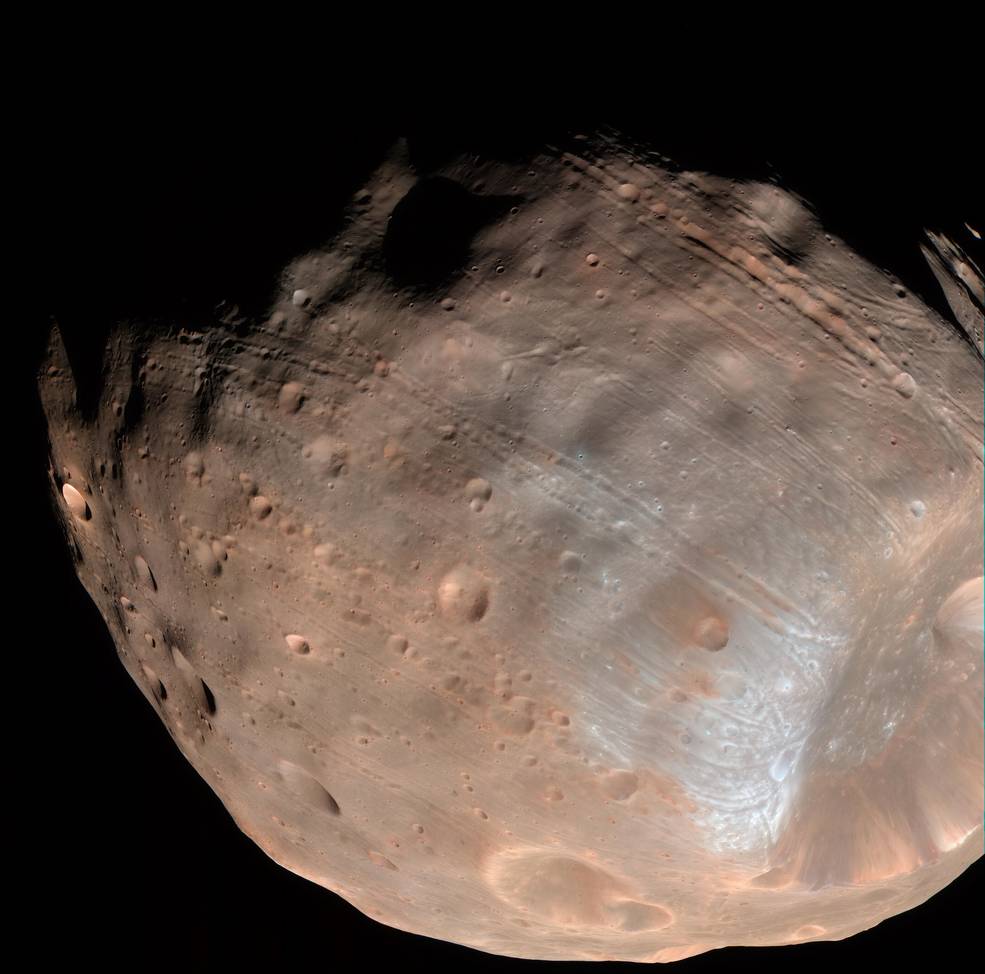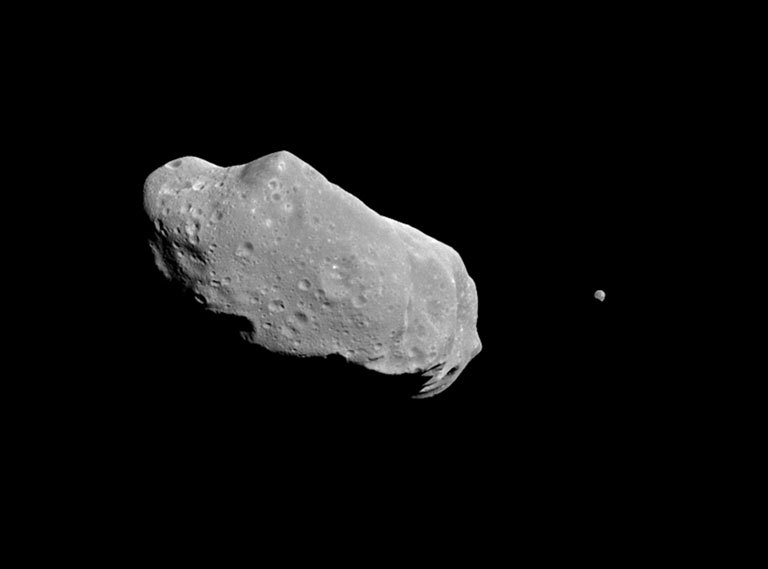Coming to the last of the inner planets in our Solar System, we arrive at Mars. Bright red in colour and the fourth planet from the Sun, Mars is named after the Roman God of War. Iron in the Martian soil has reacted with water, forming rust and therefore giving the planet its bloody red colour.
Although it is the second smallest planet in our solar system, it is one of the most explored bodies and is the most Earth-like world that orbits our Sun, and for all we know, it may as well harbor primitive life.
Two rovers – Spirit and Opportunity, landed on Mars in 2004, and worked there much longer than their planned mission which was supposed to last for 90 days. Spirit lasted for about 6 years and Opportunity lasted for nearly 15 (it broke the record for the most miles on a speedometer in extraterrestrial travel). The twin rovers found evidence that the planet had water on its surface a few billion years ago, and the conditions then were suitable for primitive life to form.
Organic molecules are the building blocks of life, and these were discovered by NASA’s Curiosity Rover from a sample of soil it drilled from Mount Sharp. This doesn’t necessarily mean that life exists on Mars, but shows that these raw materials could have formed life in the past.

Picture Credit – NASA/JPL/USGS

Picture Credit – NASA/JPL-Caltech
The picture below shows a pool of ice that has formed in the crater Vastitas Borealis. 35 km across, this crater lies on a northern plain, where temperatures are low throughout the year (like Earth). In the polar regions of Mars, ice and frozen carbon dioxide are found at all times of the year.


Picture Credit – NASA/JPL-Caltech/MSSS/TAMU
Mars has two tiny moons – Phobos and Deimos. Phobos orbits Mars just 9,400 km above, at rapid speed, completing one orbit in just 7 hours and 40 minutes. It is slowly getting pulled into Mars because of its gravity, and is estimated to collide with it in about 50 million years.

Picture Credit – NASA/JPL-Caltech/University of Arizona
Between Mars and the next planet Jupiter, lies the Asteroid Belt. Most of the known asteroids orbit in this belt, usually not with elongated orbits. 1 to 1.9 million asteroids larger than 1 kilometer in diameter and millions of smaller ones are estimated to be in this belt. They are remnants of worlds that could never be, due to the gravity of a young Jupiter in the early days of the Solar System. Jupiter’s gravity caused these rocks to collide, making them break up into smaller fragments, thereby forming the asteroids we observe today.

Picture Credit – NASA/JPL
Fittingly named after the Roman King of Gods, the largest in our Solar System and the first of the outer planets, lies the magnificent Jupiter, whose orbit lies 778 million kilometers (5.2 AU) away from the Sun. (One AU/Astronomical Unit is the distance between the Sun and Earth – almost 150 million km.) Light from the Sun takes 42 minutes to reach Jupiter, and understandably, one year on Jupiter is equivalent to 4,333 Earth days or 11.8 Earth years, because of the size of its orbit. This planet is more than twice as massive than all the other planets combined.
As you probably know, Jupiter is a gas giant, and astronomers think that if it has a solid core, it would be the size of the Earth. The gases in Jupiter’s atmosphere are mainly hydrogen and helium, like the sun. This is because it formed about 4.5 billion years ago and it contains the remaining ingredients of the Sun that couldn’t join our home star. That’s why it has the same materials that it takes to make a star, but it wasn’t big enough to burn.
Here’s a fun fact – Jupiter contains the largest ocean in the Solar System – an ocean of liquid hydrogen!
In 1979, the Voyager Spacecraft discovered that all the four outer planets in our Solar System have rings. Jupiter’s rings form the Jovian Ring System. The planet has 4 sets of rings, and unlike Saturn’s icy ones, this gas giant’s are made of dust, and are not visible by the naked eye from Earth.

Picture Credit – NASA, ESA, A. Simon (Goddard Space Flight Center), and M.H. Wong (University of California, Berkeley)

Picture Credit – NASA/JPL-Caltech/SwRI/ASI/INAF/JIRAM
So far, 9 spacecraft have visited Jupiter and Juno – the latest one, went there in 2016. Astronomers also use the Hubble Telescope which orbits the Earth to regularly see the planet. Jupiter has a great impact on humanity’s view of space. In 1610, when the astronomer Galileo Galilei invented the telescope, and looked at Jupiter. He saw its moons, and this ended the wrong assumption that Earth was at the center and the Sun and other planets orbited it.
The planet doesn’t have a proper surface, it mainly has only swirling gases and liquids. No spacecraft would actually be able to land on it, but it would only be subjected to the high pressure and storms of Jupiter.
Now, coming to Jupiter’s potential for life, the planet is inhospitable for life as we know it to adapt the extreme conditions there. However, Europa – one of Jupiter’s 79 moons, may have the potential for life as we have discovered oceans under its surface.
53 of those 79 moons have been confirmed while the remaining 26 await confirmation. Out of all these moons, the Galilean satellites – which are the first 4 to be discovered are the most interesting to explore.

The following pictures show the moons Io, Europa, Ganymede and Callisto…
- The first picture – Io, third largest of Jupiter’s moons, enduring a volcanic explosion, taken by NASA’s New Horizons Spacecraft. Picture Credit – NASA’s Goddard Space Flight Center Cover image courtesy of NASA/JPL/University of Arizona
- The second picture shows Europa, with long cracks on its surface where surface ice crust has been broken up and refrozen into new patterns. Picture Credit – NASA/JPL-Caltech/SETI Institute
- Picture three shows Ganymede, the largest moon in our Solar System and the only moon with its own magnetic field. This is a natural colour image of Ganymede taken by the Galileo Spacecraft on their first encounter. Picture Credit – NASA/JPL
- The fourth picture shows Callisto, a geologically inactive world, using images taken by Voyager 1. The central bright spot shows the impact feature Valhalla about 600 km across, with concentric bright rings that extend outward about 1500 km from the impact crater.
The next mission to explore Jupiter is NASA’s Europa Clipper. Clipper will help us investigate Europa to find out whether this icy body has conditions suitable for harbouring life.
And that ends today’s post, I hope you liked it! Thank you for reading!!
Links you might want to explore –





ooooooh!
LikeLiked by 1 person
Info packed and written in a lucid way – I learned a lot!
LikeLiked by 1 person
Niceeeeee!!
LikeLike
Thank you!!
LikeLike